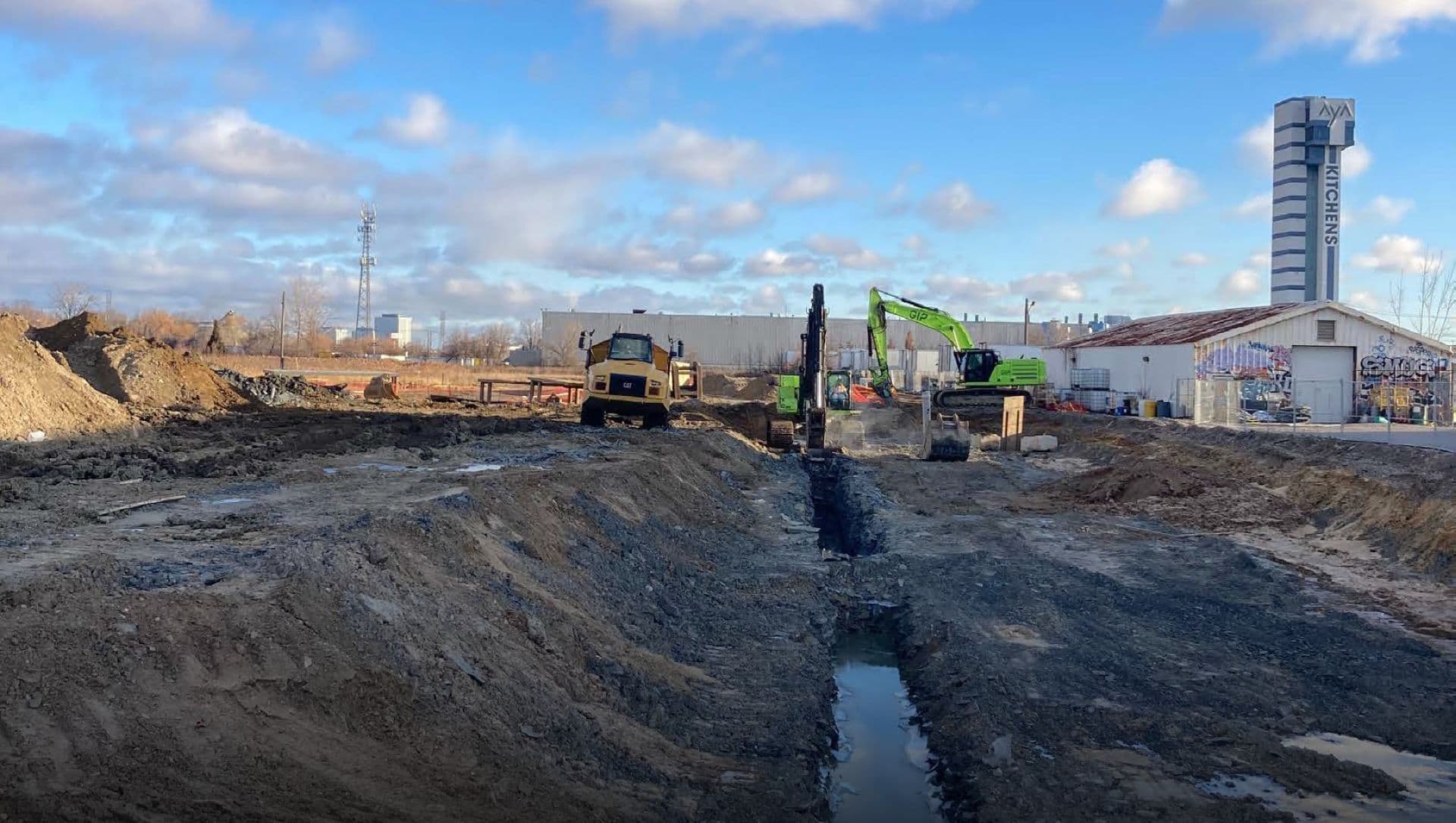Some projects stand out not just for their complexity, but for the ingenuity and teamwork required to overcome them. This year, one of those projects earned Pinchin Ltd. a celebrated Brownie Award in the Remediate category for Technological Innovation, and all of us at VEI Contracting are honoured to have been a key part of the team behind it.
This hazardous brownfield property had lain dormant for decades, shaped by a long and complicated industrial past and several previous remedial efforts that were ultimately unsuccessful. The site contained a uniquely difficult combination of contaminants, including:
- Polychlorinated biphenyls (PCBs)
- Chlorinated volatile organic compounds (CVOCs), such as trichloroethylene (TCE), cis-1,2-dichloroethylene (cDCE), and vinyl chloride (VC)
- Petroleum hydrocarbons (PHCs)
- Free-phase product (LNAPL)

These contaminants occurred within a subsurface profile transitioning from transmissive overburden soils into fractured / weathered bedrock, creating a challenging hydraulic environment with the potential for off-site migration. Redeveloping this 5.9 hectare (14.6 acre) site required an innovative, integrated, and highly coordinated remediation strategy.
The solution combined an engineered Encapsulation Zone with a funnel-and-gate style permeable reactive barrier (PRB) – an approach designed to safely manage contamination on-site while enabling redevelopment without the need to remove thousands of tonnes of impacted soil.
1. Engineered Encapsulation and Slurry Wall System
Initial assessments identified concerns around the geotechnical stability of a conventional soil–bentonite slurry wall for supporting future redevelopment activities. To address this, several enhancements were incorporated into the design:
- A geosynthetic clay liner (GCL) anchored into the trench
- Geogrid and geotextile reinforcements to strengthen key zones
- Portland cement blended into the slurry mix to increase stiffness and long-term stability
- Construction and mix-design modifications to accommodate winter conditions
These improvements created a robust Encapsulation Zone capable of safely isolating free-phase PCBs and CVOCs within the fractured bedrock.
2. A Funnel-and-Gate Permeable Reactive Barrier
Running parallel to the Encapsulation Zone, the project included more than 300 m (1,000 feet) of reactive treatment gates extending through both overburden and bedrock – the longest and deepest bedrock PRB of its kind in Canada.

VEI Contracting played a central role in the development and implementation of this system, contributing:
- Bench-scale treatability testing evaluating the treatment effectiveness of various remedial amendment combinations and concentrations
- Detailed design input, ensuring that reactive gate performance aligned with contaminant behaviour and groundwater flux through the gate sections of the PRB
- Full-scale installation, completed with stringent QA/QC oversight across all gate sections
Final Reactive Amendment Selection – Trap & Treat® CAT 100
Based on the results of treatability testing and detailed hydrogeological modeling, the reactive media selected for the PRB was Trap & Treat® CAT 100, an engineered activated carbon-based material impregnated with elemental iron and enhanced with an additional biological treatment mechanism for more complex and recalcitrant contaminants like PCBs.
VEI developed gate-specific and stratigraphy-specific CAT 100 loading rates, tailored to the unique contaminant mixtures, groundwater velocities, and geological conditions in both the overburden and weathered bedrock zones. This customized design ensured that each gate achieved the required treatment performance and long-term stability.
Post implementation groundwater sampling indicates that the boundary control feature is operating as designed to prevent the off-site migration of contaminated groundwater.

The selected approach proved to be exceptionally effective. By integrating encapsulation, boundary control, reactive treatment, hotspot remediation, free-product isolation, and vapour mitigation into one coordinated system, the project achieved redevelopment-ready conditions at a fraction of the cost and time of traditional remediation.
- Approximate project cost: ~$10 million
- Estimated cost for full excavation/removal: ~$100 million
- Significant schedule savings, enabling redevelopment years ahead of conventional timelines
The success of this effort reflects the strength of the multidisciplinary project team and the willingness of all parties to embrace creative, non-traditional solutions.
The Brownie Award rightfully recognizes Pinchin’s leadership in this challenging project. It also reflects the collective effort of everyone involved. VEI is proud to have provided the scientific foundation, remedial design support, and specialized field implementation procedures needed to bring the reactive barrier system to life.
Working alongside Pinchin on a project of this scale and sophistication has been a privilege. Together, we helped transform a long-dormant hazardous site into a property ready for safe, productive redevelopment.
Congratulations, Pinchin
To our colleagues at Pinchin: Congratulations on this outstanding achievement!

Thank you for trusting VEI Contracting to help deliver one of the most innovative and impactful remediation projects in Canada. We look forward to continuing our collaboration on future projects – especially the ones that demand unconventional thinking and exceptional teamwork.